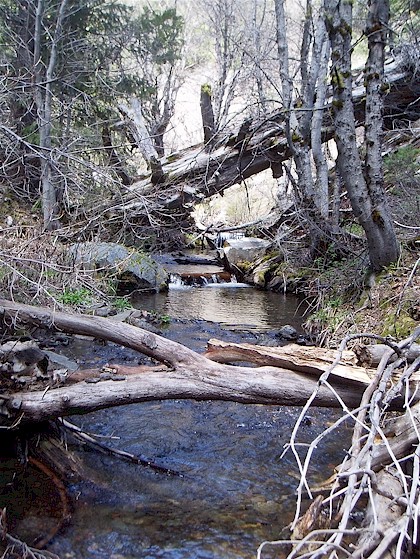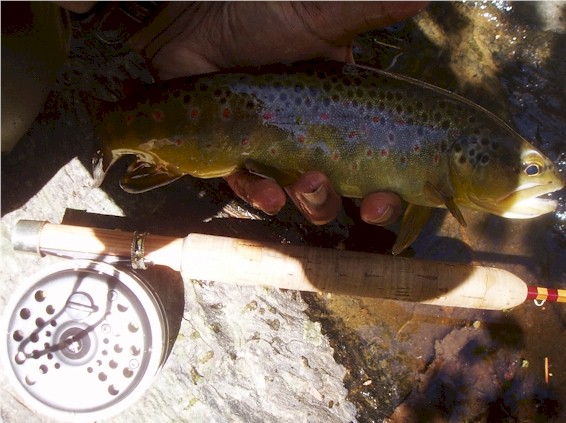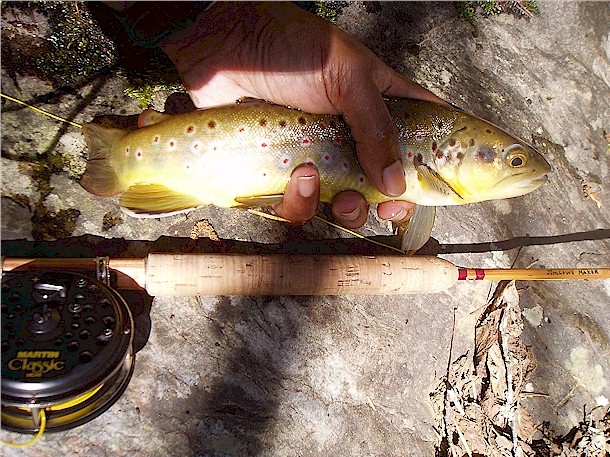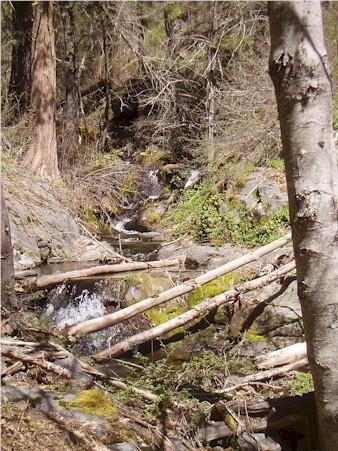|
|
|
|
|
May 11, 2007 - Butterball Creek
Time:
11:30am - 2:30pm Butterball Narrative:
The names tick by slowly at first- Tracy, Manteca, Escalon, Oakdale, Knights Ferry. Iíve made this drive too many times to count. This is my gateway to the Eastern Sierra. I pass into historic gold rush country. The hills are still slightly green and the names come quicker now- Copperopolis, Moccasin, Old Priest Grade Road. Iím shortly into Big Oak Flat and then Groveland. I know this road, all its twists and turns and can maintain the speed limit throughout when others slow to a crawl around each corner. Folks speed past me on the flats but once we get within 40 miles of the park boundary- Iím gone. The ranger at the pay station tells me Tioga Pass is open. May 11th, the earliest in my memory. The high country season's coming early this year. Once in the park I continue to maintain the speed limit. Those that were behind me, if they catch up, donít. Speed kills in the park, especially around Crane Flat which sees a lot of wildlife crossing the road. Donít do it. In addition to wildlife, Iíve seen people flip their cars. The roads in Yosemite are slippery when wet. At the trailhead, the parking lot is packed. Ironic considering it's Friday and last Saturday the lot was empty. Butterball is a secret stream of sorts but each outing at least a half dozen hikers learn of itís fishing as they pass me hiking in or out. Today that number will reach as high as a dozen. One of them is a fishermen. I know my days of solitude on this stream are numbered. I hit the trail and the local wildlife is treated to as many verses of ďWhat Should We Do With A Drunken SailorĒ as I can belt out between the trailhead and the creek. I know two verses and make up the rest. Once again I enter the shrinking machine as the Giant Sequoia soon dwarf everything in sight. Butterball Creek is 44 degrees today, 5 degrees warmer than the 39 degrees I found last week and boy what a difference 5 degrees can make. The fish were present and accounted for and on station. That didnít make the fishing any easier. This can be a tough place when conditions are as they are currently. The water is low and crystal clear. The bank is choked with brush and as luck would have it, this brush hangs low over stream. There are very few places where you can truly cast, few places you can even attempt a roll cast. The leaves are just past budding stage now and the new leaves easily catch unattended, poorly handled or poorly cast line. The fish are sensitive to any movement, above water or below. Under these conditions, it would be easy to stay that ďstealthĒ is required. Thatís too vague. Specifically, I have to slow down- slow everything, movement, casting, observation, even thinking. Relax, slow down, take it all in. Position is key, position, position, position. Itís all about position in these conditions. How do you approach the stream? Whereís the sun, is youíre shadow on the water? Can you approach the stream without being seen? Whereís the fish, is it dead center in the middle of the run or near or under cover? Can you use this cover, a rock or a log, to hide your approach and your presentation? The best position for approach might not be best for presentation. What are the currents doing? Fish in small plunge pools often face down stream. Whatís your line doing? Is it hanging loose and likely to snag a single branch and shake the entire bush? Whereís your rod tip? Itís best to
approach a stream with the rod tip behind you if possible but on this type
of stream, you have to keep your rod tip in front of you to avoid catching a
stray branch. We fly fishers have a tendency to tip the rod up as we move
with it but here it needs to stay low and remember it sits out in front of
you several feet. When you pull line off your reel are you unknowingly
extending your rod or rod tip? Whatís your line doing? Is it trailing off
down stream as you pull more line off and potentially tangling on brush or
underwater debris? Itís best to coil the line in your hand if possible. Whatís the game plan once the cast is made? Does an overhead branch prevent a good hooks set? What sort of hook set do you have to make to avoid tangling and spooking fish in the process? Whatís your second cast going to be? Do you need to gather all the line or can you use a bow and arrow roll cast? Will the line or fly catch on something as it floats back to you? And oh, donít forget your drift. If you present the fly straight up stream the line will probably get pulled by the tongue of current at the tail and help your dead drifting fly break the sound barrier. Lift the rod tip to prevent drag and the fish spook. You were probably better off with the atomic fly. Itís a lot to think about and it can take a while to find your groove. I start where I started last week. Instead of fishing up the right bank, I fish up the left. This is a mistake. At first it looks like easier going but, itís steeper and presentation is harder. I spook fish after fish until I find myself at the sunlit run I caught my first fish at last week. I canít see a fish but I am sure there is one. With the last several casts the splash of my bead head Prince Nymph has sent fish scurrying for cover. Iíve tried several different weights all with the same result. Itís past time for a dry fly. You know those times when youíve been attentive to your surroundings and you know the perfect fly to put on? Instead of that perfect fly you open your box and put on a confidence fly or worse, an ugly fly. Youíve watched the fish, the water, the bugs. You say to yourself, ďIím going to put on a size 20 Baetis CrippleĒ and instead you pull out a size 16 Elk Hair Caddis, simply becauseÖ. itís a ďgood fly.Ē Worse yet you never do put on the Baetis Cripple and never do catch fish or you catch few. Iím having one of those moments. On the bank I noticed large numbers of terrestrials Ė mostly lady bugs and ants. Nice large ants and I just so happen to have in my box some ants I tied up last week. I say to myself, ďIím going to put on that black ant I came up with.Ē I open my box and my hand goes right to the Elk Hair Caddis. I fight the urge. I am thinking to myself:
ďJust this once put on the right
fly.Ē If you lived in my head youíd often hear dialogue such as this. I make the right choice and put on the ant. I make a bow and arrow cast to the same position as last week. No fish. I make another cast a little farther up the pool. The ant lands with a plop. The eight inch brownie doesnít hesitate, I see him move across the pool and smack the fly. Fish on! Finally. Inelegantly, I climb out of the stream and through the brush. In another 2 weeks or so, the leaves will be fully developed and this stream will be almost impossible to fish. I make my way downstream to below the confluence of another creek so that I can fish my way up the second canyon. I crest some large rocks above the stream and see a huge torpedo shape scurry upstream- not in a panic but with sort of an ďI see youĒ attitude. I estimate it to be at least 14 inches. Itís the largest fish Iíve seen here and it must have been sitting in 4 inches of water.
I duck walk up stream about 15 feet. Iím fishing real skinny water now. Upstream I was fishing plunge pools and runs, now Iím kneeling in a riffle, sitting back on my heels and my knees are barely covered. I make my first cast under a low tree branch. It falls short. I donít want to make too many casts and I donít want to hang up. Both of which would spoil the run. I make the next cast to a nice tongue of flat water and a fish from the left strikes. I miss and send another cast into the same area. No response. Iíve had my chance, time to move on. Farther up I make another cast, a huge wake moves out from directly in front of me. It looks less like a fish swimming down and across and more like a very large fish simply turning down and to the left. I flub the hook set. #@$#&! The wake slowly moves its way upstream to the large pool just above. I catch a few smaller fish moving up to the big pool. The pool is the biggest and deepest Iíve seen on the creek. 20 feet long, 10 feet wide and so deep I donít think I could wade up it. I crawl closer and closer to position myself for a cast to the tail. Iím just about in position when a fish nervously swims out from just above me and into the deep center of the pool for protection. ďCrap! Too close!Ē I gather up line for a cast and release. Before the line hits the water another fish shoots upstream. Sure that Iíve spooked all the fish at the tail, I waddle my way to were I can reach every position in the pool with several long bow and arrow casts. For the umpteenth time today a small stonefly lands on my leg. Itís tiny with a brown molted wing and dark body. Iíve never seen one like it before and decide to double my chances and fish two dry flies- a brown elk hair caddis for the stone and the black ant. Itís a good thought but only one in ten fish takes the caddis. I work the pool systematically. Short casts at first and then longer. The ant becomes water logged and floats just under the surface film. The EHC floats. Iíve seen all the takes to the ant today but this next one takes me by surprise. I watch as the pair of flies float back to me. Iím looking for and expect to see a splash or some other obvious disturbance on the water. Instead, there is just a slight bulge and then the Elk Hair Caddis begins to pull away from me. It is subtle and takes a second for me to register. Fish on! Itís a big fish too. Even if I couldnít feel the tug or see the yellow flashes underwater, the rise to the fly would have told me that. I play the fish and land my largest fish on this stream to date.
The fishless hour or two this morning is a distant memory and Iím finally in the grove. I move up to the next pool. Itís small and typical of this stream. On the second cast I miss a strike and several more casts to the pool bring no others. Iím at the confluence now and start my way up the unfamiliar fork. Immediately there is a rush of excitement as I can see several large fish in the pool above. At first I only see the one but then I realize there are more. They are active and competing with each other for food. The pool is a good size, 6 feet long and about 3 feet wide at the tail. Itís narrow at the top where water falls over a small cascade. Itís deepest on the left where the water flows around a beach ball size rock and under some low branches. At the wide tail the water falls a about a foot to the slick rock below before flowing into a proper gravel filled pool. I can see two fish at the very edge of the tail out, one under the tree and a fourth, just to the right of the tree. I take advantage of the slight drop to the pool below to slide in so that my shoulders are level with the fish. The tail of the fish closest to me beats a bit faster then slows back down. I try to make a bow and arrow cast under the brush and catch a branch. All four fish scurry around in a panic. A slight tug and release of my line and my fly springs free. I rest the pool for a second and all but the largest fish come back. I make two additional casts. Each time the fishes charge the fly. I prick one with the fly and make several more casts. The fly is ignored. I rest the pool and watch the fish. Slowly they calm down and the largest fish returns to claim his spot. Each time Iíve cast and missed the strike or pricked a fish, itís the ant which draws all the attention. The Elk Hair Caddis is ignored as if it didnít exist. After a short while the fish have calmed and all seem to be in a good position for a cast. I make a cast to the largest fish and bedlam ensues as the fly is set up on by more than one. I strike but Iím unsure of which fish took the fly. The hooked fish struggles against my line while the others dart away in panic. Itís a good fish, skinny but nearly 14 inches.
The other fish never come out of hiding so I continue up the canyon. Itís hard going, BDTS (Black Diamond Trout Society) stuff to be sure. The stream is dead center of the canyon and steep walls form a ďVĒ on either side. Itís brushy, the soil is loose, the rocks are slick and Iím finding my new Simms Keen Wading boots are not up to snuff. Itís late so I decide to comeback another day when I have more time to explore. Back on the trail I continue with my version of ďWhat Should We Do With A Drunken SailorĒ, making up verses along way as I suspect most people do..... "Earl'ye in the mornin' ."
Previous Yosemite / Ansel Adams Wilderness Chronicle Next Yosemite / Ansel Adams Wilderness Chronicle
|





